SUMMARY
This is AI generated summarization, which may have errors. For context, always refer to the full article.
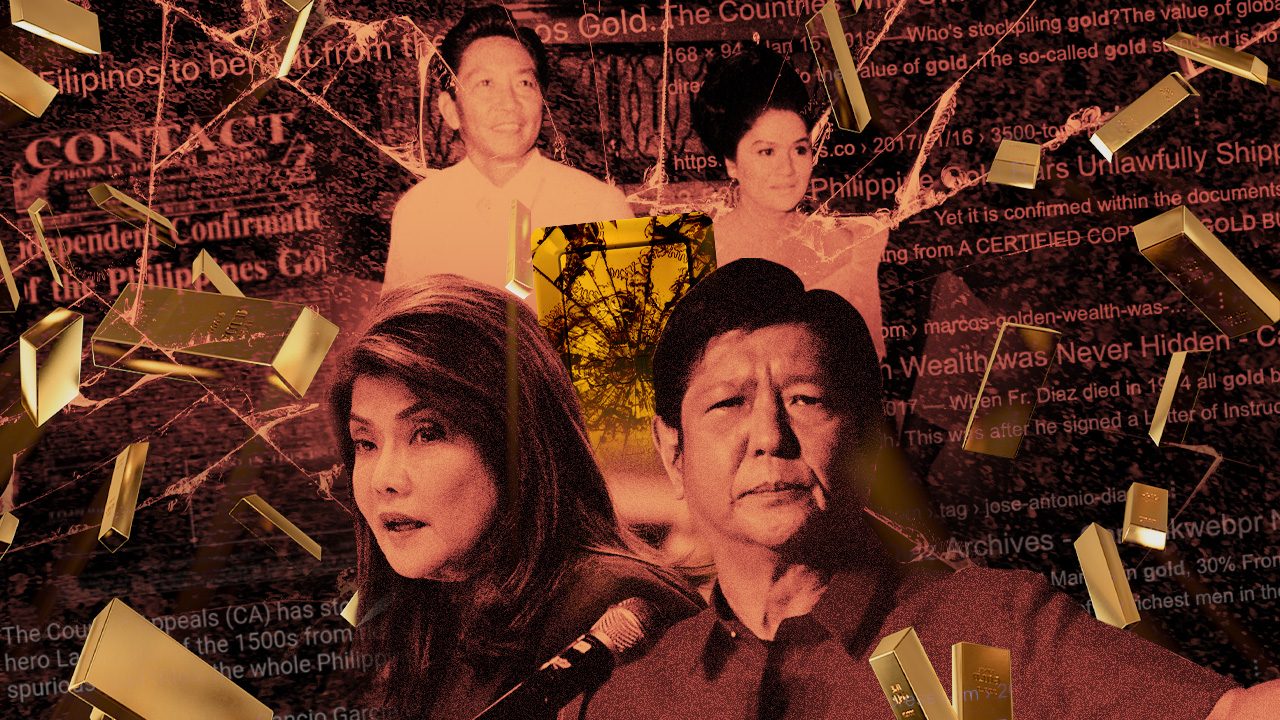
At a glance
- Myths about the Marcos gold have existed on Facebook as early as 2011. The most popular version of this myth is the so-called “Tallano” gold.
- The Marcoses and their supporters have spread the myths to justify the wealth of the family, and to convince voters that another Marcos presidency will lift the Philippines out of poverty.
- The falsehoods remained unchecked for years on social media. The accounts that pushed the false narrative dominated the online space until 2020, even after Rappler published its initial fact check in 2019.
- Groups and accounts touting the legacy of the Marcos administration amplified the false story on Facebook.
- Starting in 2021, groups and accounts fact-checking the myths increased. Historians and educators have also launched initiatives to counter the disinformation about the Marcos gold, and they are doing so as the 2022 elections near.
MANILA, Philippines – You’ve probably heard it at least once: the Marcos family has an enormous amount of gold – so huge that it could save not only the country but the whole world from poverty. They say it was earned by the late dictator Ferdinand Marcos from being a fantastic lawyer for a wealthy family called the Tallanos before he became president.
The gold is for the Filipino people, the family’s supporters would then say. But the catch is that it will only be released and distributed once Filipinos unite and re-establish the “Bagong Lipunan” or “New Society,” a movement spearheaded by Marcos when he was in power.
There are other variations of the myth, such as the existence of the Yamashita treasure from World War II and the hoax that national hero Jose Rizal bequeathed his hard-earned gold to the late dictator. No matter the origin of these myths, their aim is the same: to absolve the Marcos family from its kleptocracy, and convince people that another Marcos presidency will lift the Philippines from poverty.
The myths seem to be working. Ferdinand “Bongbong” Marcos Jr., the dictator’s son, has been the frontrunner in the presidential race since he filed his certificate of candidacy.
The myths have been shared over and over again, especially on social media. A scan of Facebook posts containing the terms “Marcos” and “gold” showed that the myth had been shared by fringe groups of Marcos loyalists as early as 2011, and was eventually further propagated by bigger partisan pages as the years went by.
As the 2022 elections approach, a network of pages and groups that debunk the mythical Marcos gold has emerged. Historians have also taken up arms because they realized that many Filipinos are now believing the lies.
Here’s what the data show about the urban legend that is the Marcos gold.
The myth has existed online as early as 2011
The myths about the gold of the Marcoses remained unchecked for many years. Rappler, for one, fact-checked the Tallano gold myth back in 2019. Citing historian Xiao Chua, the fact check piece laid out five reasons why there was just no historical proof that a royal family called Tallano ruled over a kingdom called Maharlika during pre-colonial Philippines.
However, it took a while for the fact checks to catch up to the posts promoting the myth on Facebook.
Facebook data show that posts about the Marcos gold have existed as early as 2011. There were only a few posts from 2011 until 2013, but the volume gradually grew from 2014 to 2020. During this period, Marcos Jr. ran for the vice presidency in the 2016 elections and his sister Imee won a Senate seat in 2019. The volume of posts then skyrocketed in 2021, when Bongbong filed his certificate of candidacy for president, reaching a peak of over 21,000 posts that year.
The trend is similar to how Marcos fan groups and pages were created over the years. An earlier Rappler investigation showed that these types of groups started to increase in 2014, around the time former first lady Imelda Marcos first mentioned she wanted her son to run for president.
The earliest posts found in the scan touched on different versions of the Marcos gold myth. There was the Yamashita gold hoax, which said that the late dictator’s fortune came from the purported treasure left by Japanese General Yamashita after World War II, and the supposed existence of the Maharlika kingdom ruled over by the Tagean-Tallano clan.

These stories aimed to establish that the late dictator was already wealthy even before he became president, so there was no reason for him to steal public funds. (FALSE: It’s impossible for Marcos’ wealth to be sourced from public funds)
From 2014 onwards, Facebook pages by Marcos loyalist fringe groups played a big role in the spread of the tale of the Tallano gold, which appeared to be the most popular variation of the Marcos gold myths. In the list of the top 15 groups and pages with the most posts about the Marcos gold, three were Facebook pages dedicated to posting content that combined theology and conspiracy theories to perpetuate the belief that the Tallano gold exists.
These pages are the “Alpha Omega World Development Marshall Programme,” “THE UNIVERSAL QUEEN OF QUEENS FOUNDATION INC.,” and “Alpha Omega World Dev’t Marshall Programme Phils.” The first two pages’ earliest posts containing the terms Marcos and gold were shared in 2014, while the third page’s was in 2016. All three pages have continued to post about Marcos gold as of March 2022.
The common thread between these pages is Tiburcio “TVM” Marcos, the so-called “world chairman” of both groups – the Alpha Omega World Development Marshall Programme and The Universal Queen of Queens Foundation – which both have the mission to “eradicate poverty and uplift the dignity of the Filipino people.”

Tiburcio Marcos has made several fantastic claims in the past, including his declaration that he is the only “legitimate” son of the late dictator Ferdinand and that he is the “last successor heir” of the non-existent pre-colonial family Ferdinand lawyered for, the Tallanos. Like Marcos Jr., Tiburcio had filed his certificate of candidacy to run for president in the 2022 elections, but he was later declared a nuisance candidate by the Commission on Elections. He has also spread the conspiracy theory that Marcos Jr. is an “impostor” of the real Bongbong who supposedly died in 1975. (READ: Stuff made for fact checks: Petition accuses Bongbong Marcos of faking… himself)
Such conspiracy theories are also present in the pages of the organizations he heads. The other unfounded assertions that the pages have propagated include the claim that Philippine national hero Jose Rizal owned a “White Vatican Account” containing gold, which the late dictator supposedly inherited. There were even false claims that Rizal and Ferdinand established the World Bank.
These narratives continued to multiply on different social media platforms over the years, including Facebook, YouTube, and TikTok. The Facebook scan showed that the words “Tallano,” “Vatican,” “Maharlika,” and “Aquino” were the top words included in posts about the supposed Marcos gold.
The myth goes mainstream
Today, posts about the supposed Marcos gold are abundant on Facebook, with bigger accounts sharing content about the myth. This means that the myth is no longer just an urban legend propagated by fringe groups. They are also now used to convince people for a potential Marcos comeback to Malacañang.
All of the posts included in the scan were then run under community detection to determine different networks of accounts. The community detection connected the accounts that shared the same link, and communities formed when a group of accounts was found to share the same sources. The data showed five main communities:
- Fringe groups
- Fact checkers and media
- Marcos legacy groups and pages
- Marcos-Duterte and fake history groups
- Uniteam supporters
(The network map below shows the communities on Facebook sharing content about Marcos gold. Please allow time for the data visualization to load.)
Although the fringe groups started the conversations, they are few compared to the other communities. Prior to the surge of posts in 2021, most of the posts about Marcos gold could be attributed to the third community that’s composed of groups and pages sharing exaggerated achievements of the Marcos regime. Accounts in this community started to dominate the network in 2015 and continued to do so even after the initial fact checks done by Rappler in 2019 and Vera Files in 2020.
A key representative of this community is the Facebook page PSSAP (PARA SA SAMBAYANANG PILIPINO) Underground Media, a recidivist pro-Marcos account that has been flagged several times by third-party fact checkers for sharing false information. This account has also attacked journalists and media groups for reporting critically about the Marcoses.
The scan found that the posts with the highest shares on Facebook belong to the community of Marcos legacy groups and pages. These were:

These four pages have all been flagged for posting false information in the past.
The fifth community, which is mostly composed of accounts supporting the Bongbong-Sara Duterte Uniteam alliance, is a fairly new community that only ramped up its sharing of posts about the supposed Marcos gold starting in October 2021. It is slightly different from the fourth community, the Marcos-Duterte and fake history groups, which has been sharing the myth as early as 2016. The community of the Marcos-Duterte and fake history groups also contained posts supportive of the respective fathers of the Uniteam tandem.
Of the five communities, only the community of fact checkers and media contains accounts with posts that debunk the myth. It also includes the verified pages of news organizations, such as Rappler, Philippine Star, Inquirer.net, OnePH, and Philstar.com.
Impact of fact checking
The top terms included in the posts were also tracked alongside the terms “fake,” “false,” or “hindi totoo (not true)” to compare how many posts were debunking the myth, and to track when they started to ramp up.
The data show that the number of posts containing the keywords “fake,” “false,” or “hindi totoo” was lagging behind the other keywords until the third quarter of 2021, but it surged to the second spot by the last quarter of 2021. It was in October 2021 when Marcos Jr. announced that he would run for the presidency.
This is also evident in the community maps when split by year. Posts by the community of fact checkers and the media have started to outnumber the rest starting in 2021, while posts from the communities of fringe groups and Marcos legacy pages decreased between January and March 2022.

Francisco Jayme Paolo Guiang, assistant professor at the University of the Philippines Department of History, said that the Marcos gold myths have been around even before social media became popular in the Philippines, but there were no attempts to study or disprove them because it was considered a mere rumor. He said that the myths spread around were purely anecdotal, and there were just no primary sources that could confirm the existence of the gold.
“The reason why there are no academic studies before to focus on this myth is that it doesn’t affect public discourse. So it doesn’t require professional attention from professional historians. Now, there are so many people who believe [that the Marcoses will distribute gold once they win],” Guiang told Rappler in a mix of English and Filipino in an interview in April 2022.
Chua, whom Rappler consulted for its 2019 fact check on the Tallano gold, gave the same explanation for why historians never really paid attention to the myths before. “Because we never thought people will really believe it. There is always a saying, ang pumatol sa siraulo ay siraulo (he who engages with a deranged person is himself deranged),” Chua said in a message to Rappler in April 2022.
Guiang explained that, in doing historical analysis, primary sources are important. This proved to be a major consideration among historians because they couldn’t delve into topics that were only based on hearsay.
“The most common among the versions [of the gold myth] is that there is no single primary source that can prove that there is gold in existence that came from a Tallano clan, for example, or the so-called Yamashita, or whatnot. The evidence that we have when it comes to the wealth of the Marcoses is the paper trail that points to graft and corruption. There are court records,” Guiang said.
Guiang is also a convenor of the Akademiya at Bayan Kontra Disimpormasyon at Dayaan (ABKD), a network of educators and academic institutions established in 2021 to fight disinformation and fraud in the 2022 elections. The group actively campaigns against historical distortions by hosting different webinars and regular posting of fact checks on its Facebook page.
Still, the accounts pushing back against the disinformation surrounding the fabled Marcos gold have a long way to go. In the list of the top 10 accounts with the highest interactions (likes, comments, and shares) on their posts about the Marcos gold since 2011, only four accounts belong to the community of fact checkers and the media.


Guiang also admitted that their response had been reactive, but maintained that it was still essential. “Medyo naghahabol, pero ayun nga eh, seryosong problema na siya,” he said. (We’re trying to catch up, but it’s because it’s become a serious problem now.)
In February, ABKD hosted a webinar that debunked the Tallano gold myth. It was led by Ateneo de Manila University history professor Francis Gealogo, who refuted the related claims one by one – from the existence of the Tallano royal clan to the credibility of the sources sharing the lies.
“This doesn’t seem like an accident. This looks like an organized, systematic method that has a huge organization and funds, and there is someone orchestrating it. We need to hold accountable the actors behind this, so that we don’t blame those who were victimized by disinformation,” Gealogo said in Filipino during the webinar.
In 2018, Facebook announced that it had taken down 95 pages and 39 accounts in the Philippines that violated its spam or authenticity guidelines. A Rappler investigation showed that some of the accounts taken down were linked to the Marcos propaganda network.
In 2020, Facebook took down another batch of accounts created in March and April 2019 tied to a Chinese network. Social analytics firm Graphika said the network had a “particularly striking” focus on Imee, who ran for a Senate seat in 2019 and won. Imee admitted in January 2021 that she still holds a grudge over the takedown.
Gold or no gold? Even the Marcoses can’t agree
One widely-shared content that the supporters of the Marcoses cite in spreading the gold myth is a 2013 interview with Imelda Marcos in GMA News TV’s show Powerhouse, hosted by Mel Tiangco. Imelda talked about how her husband supposedly invested in gold early in his career, and how they were willing to share it with the world.
“No, this will save the world. This is the reason why I want to survive. And it’s not for me anymore…. [We’re willing to give to] not only the Philippines, but the world,” Imelda said.
A reverse image search of some of the frames from the interview showed that several pro-Marcos accounts have shared clips of this interview across different social media platforms to convince others that the Marcoses did not steal from the public and that another Marcos presidency could lift the Philippines out of poverty using the Marcos family’s gold.
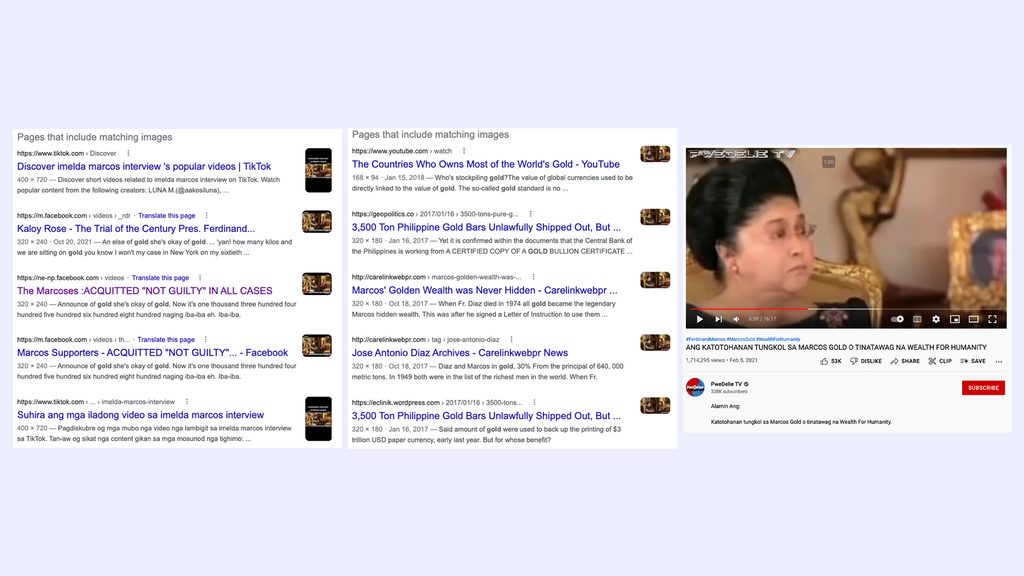
The family stood by this defense, at least until Marcos Jr. decided to run for the presidency. Newspaper clippings and court pleadings obtained by Rappler showed that he told an Inquirer journalist in 1990: “Only I know where the gold is.”
But in January, Bongbong himself denied the existence of such gold for Filipinos. “In my whole life, I have not seen any gold like that. I know many who’ve been digging here and there, but I haven’t seen any of the gold that they’ve been saying. Maybe they know something, just let me know,” Marcos Jr. said in a mix of English and Filipino in an interview with One News.
(Editor’s Note: In a previous version of this story, we mistakenly said that Bongbong denied the gold claims in January 2021. This has been corrected.)
This was also the response of Vic Rodriguez, spokesperson of Marcos Jr., when asked about the Tallano gold eight days before Marcos Jr. made his statement. (WATCH: Tallano gold? ‘Hindi ko alam iyan,’ says Marcos Jr. spokesman)
Whether or not the Marcoses and their supporters continue to believe the gold myth, the fact remains that there is no strong evidence that points to the existence of the fabled Marcos gold. More accounts appear to be taking time and effort to post on Facebook to disprove the urban legend, too, as the elections near.
The question is, will the fact checks and posts that debunk the myth now be able to reverse the damage brought by years of disinformation about the Marcos gold? – with reports from Gemma B. Mendoza, Bingbong Recto, and Don Kevin Hapal/Rappler.com
This study is part of #FactsFirstPH’s efforts in studying and tackling disinformation online, to equip voters with verified information ahead of the upcoming national and local 2022 elections. #FactsFirstPH is a coalition of more than 120 groups from the media, civil society, business, research, legal sectors, and the Church, that seek to combat disinformation.
Add a comment
How does this make you feel?
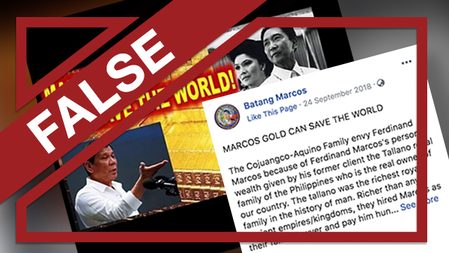
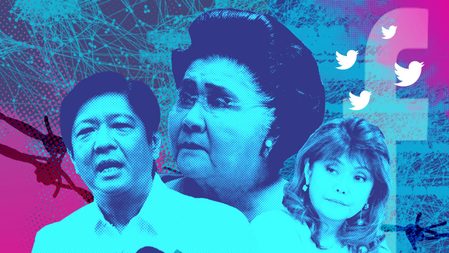
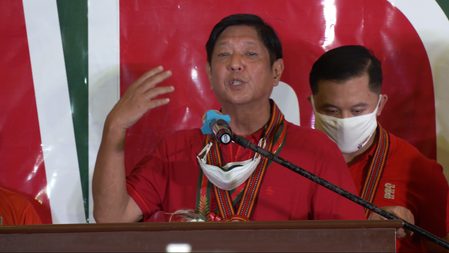
![[Be The Good] Weave your story into the state of the nation](https://www.rappler.com/tachyon/2024/07/newsletter-marcos-sona-july-17-2024.jpg?resize=257%2C257&crop=275px%2C0px%2C720px%2C720px)

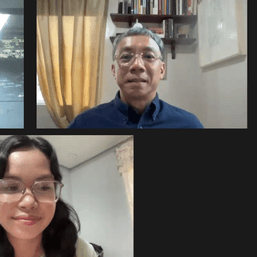
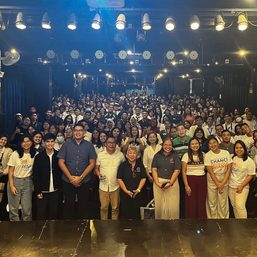
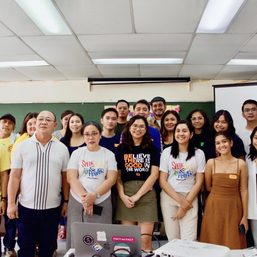


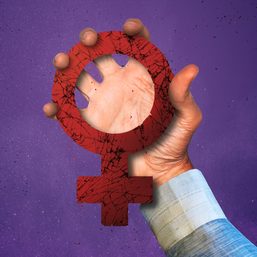
![[ANALYSIS] Cybermisogyny violates human rights](https://www.rappler.com/tachyon/2022/06/Cyber-misogyny-human-rights.jpeg?resize=257%2C257&crop_strategy=attention)
![[ANALYSIS] Building Narratives: stories of greatness and windmills in Marcos Jr.’s campaign video](https://www.rappler.com/tachyon/2022/05/Narratives-marcos-windmills-May-18-2022.jpg?resize=257%2C257&crop_strategy=attention)
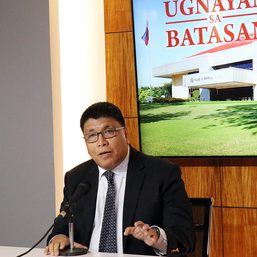
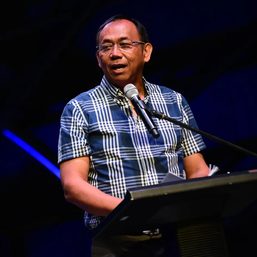
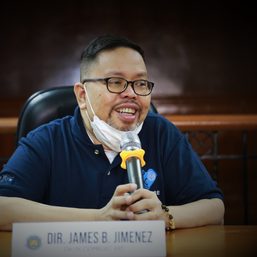
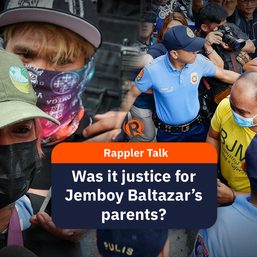
![[New School] Tama na kayo](https://www.rappler.com/tachyon/2024/02/new-school-tama-na-kayo-feb-6-2024.jpg?resize=257%2C257&crop=290px%2C0px%2C720px%2C720px)




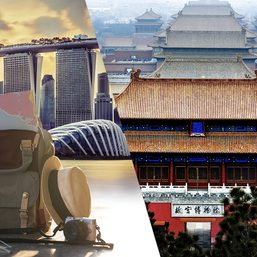
![[Closer Look] ‘Join Marcos, avert Duterte’ and the danger of expediency](https://www.rappler.com/tachyon/2024/06/TL-trillanes-duterte-expediency-june-29-2024.jpg?resize=257%2C257&crop_strategy=attention)

![[Newspoint] A Freedom Week joke](https://www.rappler.com/tachyon/2024/06/20240614-Filipino-Week-joke-1.jpg?resize=257%2C257&crop_strategy=attention)

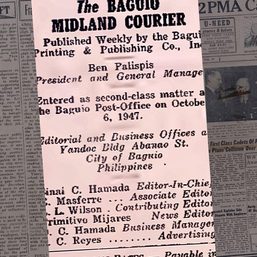


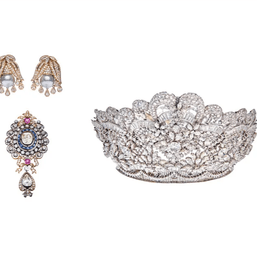
![[OPINION] If it’s Tuesday it must be Belgium – travels make over the Marcos image](https://www.rappler.com/tachyon/2024/04/tl-travel-makeovers-marcos-image.jpg?resize=257%2C257&crop_strategy=attention)
![[OPINYON] Tungkol sa naging viral na social media conjecture](https://www.rappler.com/tachyon/2024/07/thought-leaders-conjecture-07262024.jpg?resize=257%2C257&crop_strategy=attention)
![[DECODED] The Philippines and Brazil have a lot in common. Online toxicity is one.](https://www.rappler.com/tachyon/2024/07/misogyny-tech-carousel-revised-decoded-july-2024.jpg?resize=257%2C257&crop_strategy=attention)
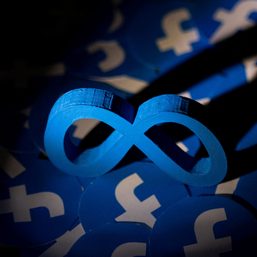

There are no comments yet. Add your comment to start the conversation.